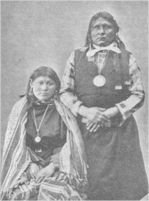Menominee Indian Totems
Chauvignerie gives their principal totems as the Large-tailed Bear Stag Kilou (a sort of eagle). Neill (Hist. Minn., 1858) classes the Menominee, evidently on French authority, as Folles Avoines of the Chat and Orignal or Wild Moose and Elk. Hoffman gives the modern totems as follows: The Owa’sse wi’dishi’anun, or Bear phratry, consisting of the following totems and sub-phratries: Owa’sse (Bear), Miqkä’no (Mud-turtle), Kitä’mi (Porcupine), with the Namä’nu (Beaver) and O’sass (Muskrat) and sub-phratries. The Kině’uv wi’dishi’anun, or Eagle phratry, consisting of the following totems: Pinäsh’iu (Bald Eagle), Kaka’k (Crow), Inä’qtěk (Raven), Ma’qkuana’ni (Red-tail Hawk), Hinanä’shiuv (Golden Eagle), Pe’niki’konau (Fish-hawk). … Read more


